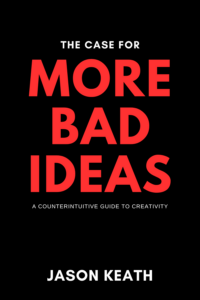
02 Oct The 3-Step Habit: A Social Media Marketers Guide to Creativity
Guest Post by Jason Keath, co-founder of Social Fresh and author of the upcoming book, “The Case for More Bad Ideas.”
More information on Jason follows the article.
 I read about 100 marketing reports every year. It’s part of my job as a strategist and creativity speaker. The platforms are constantly making adjustments. Consumer behavior is always changing. And culture shifts more quickly than most of us can keep up with.
I read about 100 marketing reports every year. It’s part of my job as a strategist and creativity speaker. The platforms are constantly making adjustments. Consumer behavior is always changing. And culture shifts more quickly than most of us can keep up with.
All of this impacts how brands show up online, and it weighs social media pros more than most.
How can marketers, social media pros, or business owners consistently develop new and creative content ideas?
I’ve studied both creativity and marketing for over 20 years now and there are consistent methods for improving your creativity. I go into detail in my new book, The Case For More Bad Ideas, the counterintuitive guide to creative. But, for today’s purposes, let’s focus on what makes content creators great at new ideas.
If you work in social media, marketing, or running your own business today, you’re already doing some of this, even if it’s just subconsciously. The below steps will help you make this into a repeatable process that you can refer to when ideas are hard to come by.
With as little as 1-2 hours a week, you can consistently improve the quality of your content ideas.
Let’s jump in.
1. Be A Trendspotter
Trendspotting is research.
The nature of the job means most marketers and social pros have to do some sort of trendspotting. You are spending time consuming content natively on social platforms and dissecting what you see with a critical eye.
The big change here is doing it with intention. First, define what intentional browsing time looks like for your process. I’ll share my basic recommendations below.
But first, you may be asking “what is intentional browsing time?”
We all have default platforms where we spend most of our time, usually 1-2 social key platforms. Today, that’s probably Instagram, TikTok, or Twitter for most of the people reading this.
My personal bias is for Twitter and TikTok, or it was until 2023. Now, it’s Threads and TikTok. I recommend you spend 30 minutes each week intentionally browsing per platform. A few tips for making this a successful process.
- Schedule this time
Schedule this if you need to for the platforms you don’t naturally default to browsing. For me, this would be time focused on browsing Instagram, Facebook, LinkedIn, and YouTube. - Be intentional about the accounts you use to browse
You may want to create specific accounts to browse from that ensure you’re getting a diverse sample of content trends, or focus an account on a specific persona. Consider following competitors, aspirational brands, and innovative creators. - Know what to look for
Learn to look for and document the content that you want to send to friends or family. And ask yourself “why?” you wanted to share it. Pay attention to posts you are bookmarking or want to comment on (whether you actually comment or not). Pay attention to content that stands out because of emotion or contrast of any kind. And start to save that content.
- Schedule this time
2. Learn To Love Lists
That research phase of intentional browsing, learning what to look for, and saving content examples means that you’re going to start making a bunch of lists.
The most creative people I know are prolific list makers.
Most social platforms make this easy with save/bookmark features. Ultimately a best practice is to save content from multiple platforms in one place. Consider Notion, Airtable, or another bookmarking tool of your choice for this. I like Airtable because it lets you add images and video easily, but it takes a little more work.
I recommend curating each of the four types of content below. These can be separate bookmark folders or one central list that allows you to use tagging. Just make sure you are capturing content from each of these groups.
Competitor Content
Monitor your major competitors or industry leaders. What content is outperforming for them? What surprised you? What looks like a new direction for them?
Best In Class
Save content from brands of any industry that are winners and outperforming. Who is taking risks, getting high engagement, and driving new trends? This is a broad list of innovation and creativity across any industry.
Creator Content
Make sure you’re following and looking out for quality influencer and creator content. Solo creators are some of the best sources for inspiration and start most of the new trends online. Always be on the lookout for new creators to follow and learn from.
Engagement Templates
The more you intentionally browse social platforms the easier it is to identify engagement templates. These are posts that can be easily adapted to work for multiple brands or purposes. When you find quality content, ask “can we do an easy version of this and make it our own?”
It’s incredibly value to build these lists, especially over a longer timeline. But, the key to getting the most value out of these lists is to review and share your insights regularly.
3. Intentionally Share With Others
Building these habits and resources for yourself is great. But, the real magic happens when you pay attention to how your ideas are impacted by communities and feedback loops.
All creatives need feedback loops. Authors have editors and readers. Painters have galleries and buyers. No one is immune.
Surrounding yourself with other creative-minded friends or colleagues is a huge source of inspiration and big ideas. There are tons of social media pro groups out there in the world, but even if that doesn’t work for you, start your own. This can look like a few things:
- Start a group chat with fellow creators relevant to your work
- Start curating your favorite ideas on social, a newsletter, or a blog
- Attend events or conferences that attract the type of creative people you want to connect with more often
- If you’re on a team start a Slack channel or equivalent for sharing inspiration
Don’t get me wrong, you can come up with a lot of ideas on your own, but at multiple stages in the creative cycle, you need outside inspiration, support, and validation. The earlier in your creative process you lean into those feedback loops, the better your ideas will become.
Conclusion
I’ll leave you with one final bonus tip. Creativity requires freedom. If you are working somewhere that for whatever reason does not allow you the agency you need to take creative risks, recognize that, and look for opportunities that allow for more creative freedom. And that doesn’t always mean you need to search for a new employer.
There will always be a balance between the exciting-fun work and the dry-boring work. C’est la vie.
Hugh MacLeod’s “Sex and Cash Theory” is one of the best takes on this.
“The creative person basically has two kinds of jobs: One is the sexy, creative kind. Second is the kind that pays the bills. Sometimes the assignment covers both bases, but not often.”
There’s always a way to get at the creative work. If it’s not directly in front of you today, you may have to go out and build that opportunity for yourself.
 About the author:
About the author:
Jason Keath is an author, creativity keynote speaker, and co-founder of Social Fresh. He believes in the power of unconventional thinking and experimentation. His book, “The Case for More Bad Ideas,” advocates for embracing counterintuitive ideas to foster breakthrough thinking. Keath’s approach encourages teams to step outside their comfort zones, take risks, and view failure as a stepping stone to success. At his creative strategy agency Social Fresh, Keath and his team develop trend reports, marketing strategy, and digital training for growth brands in finance, health, and B2B.
Contact us today to learn more about how we can help with your social media marketing.

